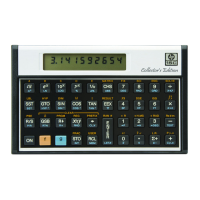iv Introduction
Users took advantage of this increased power by programming even more
interesting applications and games. One game program of special interest,
named Pinball Wizzard, was very popular (and yes, the author used two z’s in
the program name). HP accepted programs for the HP-67 and HP-97 into the
HP-67/97 Users’ Library, which ended up containing over 4800 submitted
programs.
Due to their more capable programming features and lower price point
compared to the earlier HP-65, these two new models were also widely
adopted by professionals and companies for specialized uses. The HP-67 was
sold for over 5 years while the HP-97 was sold for over 8 years. These models
certainly filled a need.
Meanwhile, HP had been developing another line of smaller programmable
calculators that did not include the ability to save programs externally. The
first of these, still remembered fondly by all who
owned one, was the HP-25, introduced on August 1,
1975. While this model only had 49 fully-merged
program steps, its small size and well-rounded feature
set created many fans. The PPC Journal published a
user-created collection of 56 programs for this model,
addressing topics from probability distributions such
as normal, binomial, hypergeometric, to math
functions such as the Bessel, Error, Gamma, and more.
Users also wrote a wide range of game programs to run
in this little marvel, such as bagels, subhunt, roulette,
blackjack, slot machine, and more.
Following the HP-25 came the HP-25C, the first
handheld calculator model with a letter at the end of
the name. Earlier HP products were normally referred
to by a number followed by a letter. With HP’s calculators, the naming was
different, and models had two digits. After the introduction of the HP-25C,
nearly all models were named with one or two digits followed by one or two
letters.
As a historical note, the letter A was the standard letter at the end of a
calculator model number, although it was not explicitly used in calculator
advertisements or manuals. So for instance, the original HP-35 was officially
the HP-35A, but was not normally referred to as such. The letter B eventually
referred to business models, C referred to a continuous memory model. The
letter E was used for the series E models discussed below (E for “Easy”—easy
to assemble as the original versions clicked together with a minimum of
HP-25C

